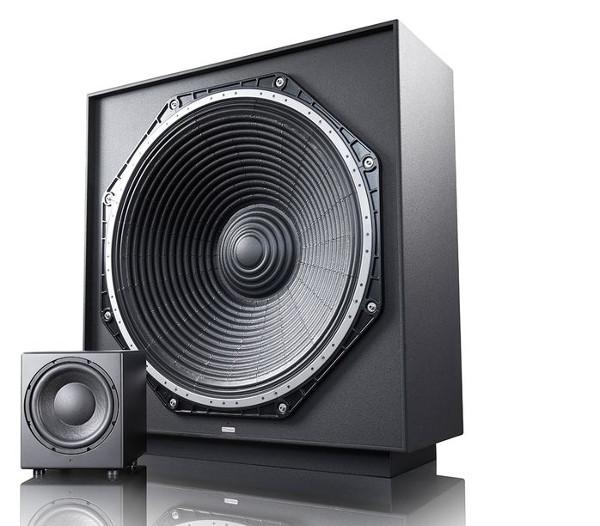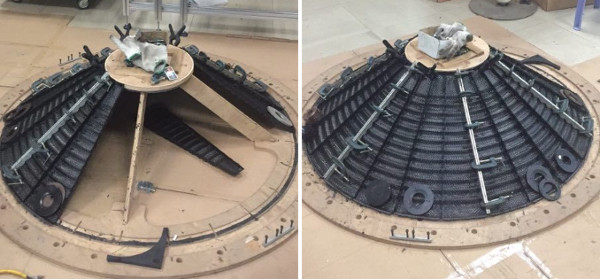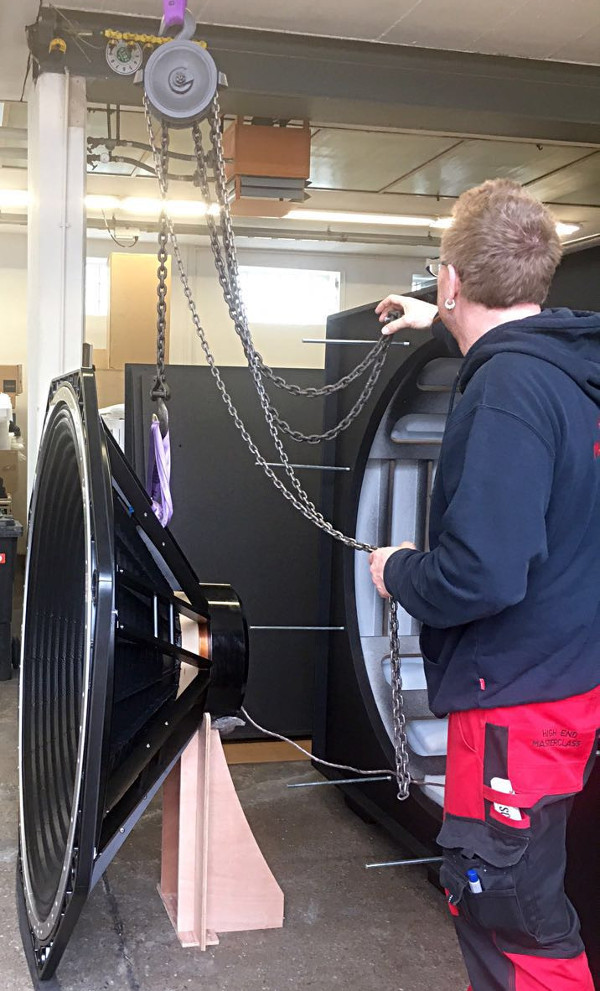Ascendo’s Seismic Subwoofer Is a Modern Marvel

S&V: The SMSG50 is a certainly a mind-blowing product. What's the story behind this gargantuan subwoofer? How did it come into being?
Geoffrey Heinzel: The birth of SMSG50, which stands for Seismic Monitor Subwoofer Geschlossen [“sealed” enclosure in German] with 50 (inches) designating its cone diameter, came to life after performing tests with all available high-excursion woofers available on the market at the time. Ascendo purchased numerous 15-, 18- and 21-inch woofers from pro-audio driver manufacturers, and none really suited the goal of reproducing very low bass plus impact and with tightness, finesse, and speed because no woofer can overcome physics.
 What do I mean by that? In order to tune an enclosure to reproduce 20 Hz, you need an enclosure of 1 to 2 cubic meters (35 to 70 cubic feet) no matter the size of the woofer. For example, placing an 18-, 21-, or even 24-inch woofer in the same enclosure yields the same results in terms of low-frequency extension. Of course, you do get more SPL at lower frequencies with the bigger woofer since it can move more air with the same excursion and stroke.
What do I mean by that? In order to tune an enclosure to reproduce 20 Hz, you need an enclosure of 1 to 2 cubic meters (35 to 70 cubic feet) no matter the size of the woofer. For example, placing an 18-, 21-, or even 24-inch woofer in the same enclosure yields the same results in terms of low-frequency extension. Of course, you do get more SPL at lower frequencies with the bigger woofer since it can move more air with the same excursion and stroke.
In the end, it is a simple equation of cone area versus the excursion required to reproduce the desired low-frequency output. It would be so easy if that was all there was to it.
But you need a woofer with a very low resonance frequency in a sealed enclosure with appropriate parameters to achieve tight bass output at, say 15, 10, or even 5 Hz. By doing the math, I realized that if I used a huge woofer with a very low resonance frequency in a very big sealed enclosure, the group delay hump shifts a few octaves downwards, and the woofer plays much tighter compared to multiple 18-inch woofers with the same combined cone area in individual enclosures (including our own!).
Additionally, for fast, tight bass, the inductance of the voice coil should be as low as possible, practically an impossible feat for high-excursion woofers due to the long voice coil wire and winding depth.
So, how did we solve this riddle?
We designed a woofer with a huge voice coil almost 14 inches in diameter (left in photo below), which gives the woofer an incredibly strong motor, driven by multiple Neodymium ring magnets totaling 40 kg (88 pounds), and custom machined pole plates and T yokes made of pure iron with very low carbon content. To machine this kind of iron, which is very brittle, it takes about 10 times as much time as regular iron or stainless steel.

Another huge challenge was to make a cone that is lightweight yet stiff enough to withstand the motor force and the air loaded onto the cone without any deformation within the useable frequency range. The only solution was to make the cone in pieces, with multiple layers of carbon composite and stiffening ribs in the back.
We also wanted to make the cone even stiffer so we introduced a technology to undulate (roll) the cone. The surround has been made of impregnated multiple roll fabric pieces glued together since a single piece of tooling was not practical. The inner suspension comprises a triple spider assembly, which is mounted to the inside of the 14-inch voice coil.

The frame was cast and machined from individual pieces of aluminum, powder coated and assembled before they were attached to the motor assembly. The woofer alone weights 135 kg (297 pounds) net, so a special crane had to be made to handle the woofer while assembling the speaker enclosure.
Lastly, the cone was glued to the voice coil with a special 3D-printed jig before the assembly was attached to the frame and motor.

The first test with the enclosure — an internally braced 21 millimeter (53/64-inch) birch plywood enclosure — was destroyed by the brute force of the woofer. We had to go back to the drawing board to design an even stiffer and thicker enclosure that would withstand the up to 9 kilowatts of mechanical power produced by the motor in this woofer.
Another huge challenge was to find an appropriate amplifier that could deliver a lot of power and even more current over an extended period of up to a few seconds. The problem with even some of the best and biggest names in pro audio is that they measure power output with crest factors — meaning they measure for only a few milliseconds at full power and then reduce power by 12 or even 24 dB for an extended period, which they claim is representative of music. This might be the case for live music in a concert setting, but for cinema LFE (low-frequency effects) — an entirely different animal — you will sometimes need full RMS power for longer periods…several seconds.
The output of all of the amplifiers we tested sagged after some milliseconds and the power delivered to the woofer was further reduced due to the current-limiting protection within the power supply. It was clear that we needed to find an amplifier that could deliver kilowatts over a longer time without sagging power. Eventually, we found one company in the U.S. that specialized in such amplifiers and they tested satisfactorily.



















































